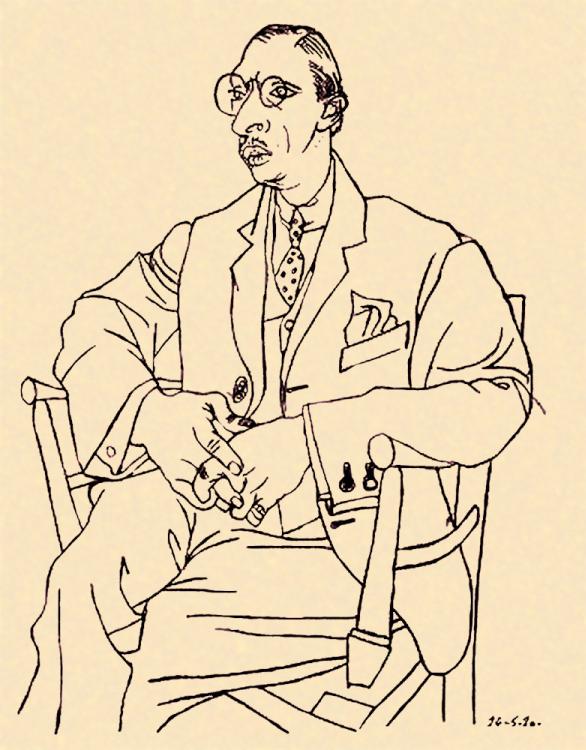
Picasso: Bull-headed Sphinx, Etching, 1933
I am not sure how Picasso does it. He takes the classical and he draws graffiti all over it and it's still the classical. Those four children's faces are clearly derived from the Greek model, the brow forming a single line with the nose. They have a clarity that is calm and unruffled even when faced by this extraordinary monster that seems to be of one body with sea and sky, all turbulence, all menace, all baroque curve and phallic aggression. And yet it too is calm. Calm as form. The composition is balanced.
The balance seems almost accidental - a kind of scribbled balance - but it's as if Picasso couldn't help but balance. Let everything be ruffled and furious and staring and even nightmarish: still it remains distilled. Distilled form is the core of classicism.
Distillation is an imperial cheat of course, a game. We know the world is not distilled into perfect form. We know the world's clumsiness and jaggedness. We understand splatter and squelch and droop and dislocation. But here we are: balanced, looking the terror in the eye and finding it too is balanced and distilled. He/she is like Rilke's famous angel, the one that serenely disdains to destroy us because its nature is serenity.
But how does Picasso do it? Can we, for a second, believe in the skeleton under the body? Can we make sense of the body at all when it looks like, say, this, or this:


The strange thing is that it is precisely the substructure that holds things together. But it isn't an anatomical substructure: it is a distilled substructure, a substructure of notions and ideas inside a code, as if the proportions of the body were immutable, permanently inscribed, carved into an ancient tribal language of psychological forms. And it calms us. It calms me anyway. I know, when looking at it, that real terror is only an imperfect copy of distilled terror, a distortion, a ballooning shape from a hall of mirrors. In other words art, or the spirit, or the imagination, or the 'rule' - that rule by which Matisse's luxe, calme et volupté remains alert and not merely sloppy, is stronger than death.
In a way.
In a very distilled sort of way.
So Picasso is both ugly and beautiful, both the terror and the distillation. And those four children aboard the lost ship are not the ones menaced. They are in control: Soyez douce, they say. And douce he is.
I prefer this to the myth of the lady and the unicorn. That lady has always been a bit too schoolmistressy for my taste.

1 comment:
You've got me thinking again George (which cannot be a bad thing after all). I was going to reply to your earlier post on this etching, but you move far too quickly for me. This will be a mite lengthy, perhaps too lengthy for a comments column. But here goes.
All four of the females are looking elsewhere (though the Sphinx's raft is in front of their boat, its head appears to be behind the first female's), so according to the natural laws of the universe/perspective, etc., it would have to be e (or f: Indifferent to the Sphinx). But of course, those laws probably don't apply here. The first three (from left to right) have similar expressions; as you said earlier, classical: suggesting a kind of regal or noble fortitude in the face of horror/terror. These three graces are presumably older/adult, young women. The fourth, though, is a child, and she is the only one who appears somewhat animated, possibly attempting to ward off the monster (she reminds me of the floating head in the right half of Guernica). The whole fits together yet doesn't. There is a stark contrast between the monster and the four females, as if they inhabited two different universes. The monster appears to be morphing out of furious hairy lines, similar to its background: the plated, fish-scale sky, whereas the females have a dark (calmer?) background and their flag is dark, heavy and tactile (rather like a mermaid's tail), too heavy to fly. Perhaps the reason the four females don't "see" the Sphinx is because the monster is more of the realms of metaphor and symbol (perhaps what they fear is an actual storm at sea, or soldiers kicking down the door, a drunken father etc.). But again, this is probably reading too much into something which should in no way be taken "literally". It seems more likely to be a stark portrayal of endurance: a clashing of opposite natures: the fearful-but-calm outfacing (or facing into) the absurdly, outlandishly, surreally terrifying: I'm reminded of Sigourney Weaver's Ripley and her 'Alien'. Picasso is a magician, supremely brilliant at reconciling opposites (or anyway essentially different textures/objects/colours/traditions etc.), as in his sculptures: the monkey with the toy car face and the beautiful 'Bull's Head', 1943, whose simplicity, grandeur and gale-force laughter flattens anything that Duchamp, Warhol (or Hirst and the YBAs) could possibly dream of.
Anyway, thanks for this etching, which I don't recall seeing before. I love Picasso's etchings; I was probably alerted to them by Berger, who talked at length about the 'artist and model' series in his 'Success and Failure of Picasso' (a book I have otherwise largely forgotten). I love Picasso's sense of line and form: "scribbled balance" is perfect. Because there is always that supreme control – in everything, even the cod-erotic phallocentric piss-takes of Greek art.
Post a Comment